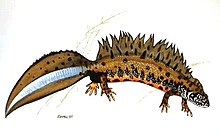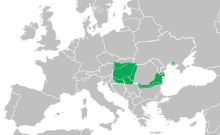
Back Triturus dobrogicus AN Дунавски гребенест тритон Bulgarian Triturus dobrogicus CEB Čolek dunajský Czech Donau-Kammmolch German Danuba krestotrituro Esperanto Triturus dobrogicus Basque Triturus dobrogicus French Podunavski vodenjak Croatian Dunai gőte Hungarian
| Danube crested newt | |
|---|---|

| |
| Scientific classification | |
| Domain: | Eukaryota |
| Kingdom: | Animalia |
| Phylum: | Chordata |
| Class: | Amphibia |
| Order: | Urodela |
| Family: | Salamandridae |
| Genus: | Triturus |
| Species: | T. dobrogicus
|
| Binomial name | |
| Triturus dobrogicus (Kiritzescu, 1903)
| |

| |
| Synonyms[2] | |
| |
The Danube crested newt or Danube newt (Triturus dobrogicus) is a species of newt found in central and eastern Europe, along the basin of the Danube river and some of its tributaries and in the Dnieper delta. It has a smaller and more slender body than the other crested newts in genus Triturus but like these, males develop a conspicuous jagged seam on back and tail during breeding season.
For half of the year or longer, adults live in slow-flowing river margins, lakes, or ponds, where reproduction takes place. Males perform a courtship display, and females lay around 200 eggs individually onto leaves of aquatic plants. Larvae develop two to four months in the water before reaching metamorphosis. For the remainder of the year, the newts live in shady land habitats, usually forests. Although not yet considered threatened, Danube crested newt populations have declined significantly, the reason being mainly habitat loss. The species is protected by law in the European Union.
- ^ Amphibian Specialist Group (2022). "Triturus dobrogicus". IUCN Red List of Threatened Species. 2022: e.T22216A89709283. doi:10.2305/IUCN.UK.2022.RLTS.T22216A89709283.en. Retrieved 27 July 2022.
- ^ Cite error: The named reference
amphibian-species-worldwas invoked but never defined (see the help page).
